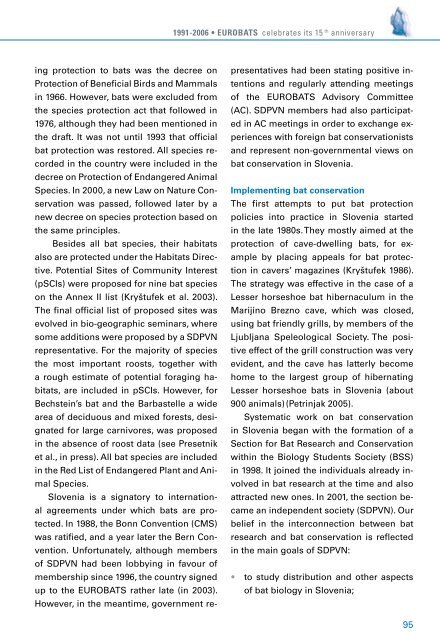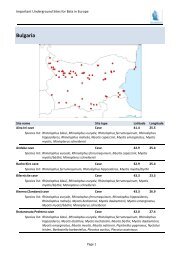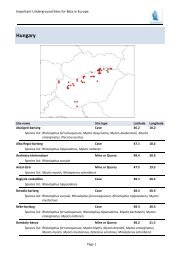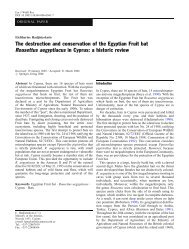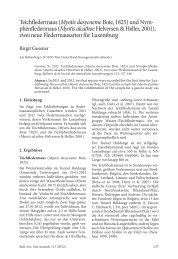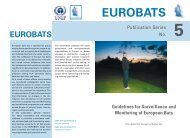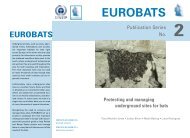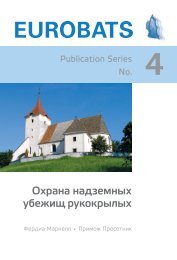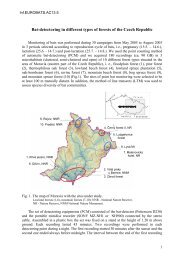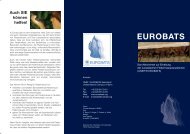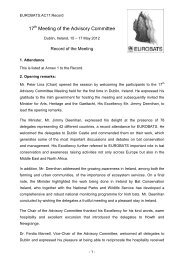1991 - 2006. EUROBATS celebrates its 15th anniversary
1991 - 2006. EUROBATS celebrates its 15th anniversary
1991 - 2006. EUROBATS celebrates its 15th anniversary
You also want an ePaper? Increase the reach of your titles
YUMPU automatically turns print PDFs into web optimized ePapers that Google loves.
ing protection to bats was the decree on<br />
Protection of Beneficial Birds and Mammals<br />
in 1966. However, bats were excluded from<br />
the species protection act that followed in<br />
1976, although they had been mentioned in<br />
the draft. It was not until 1993 that official<br />
bat protection was restored. All species re-<br />
corded in the country were included in the<br />
decree on Protection of Endangered Animal<br />
Species. In 2000, a new Law on Nature Con-<br />
servation was passed, followed later by a<br />
new decree on species protection based on<br />
the same principles.<br />
Besides all bat species, their habitats<br />
also are protected under the Habitats Direc-<br />
tive. Potential Sites of Community Interest<br />
(pSCIs) were proposed for nine bat species<br />
on the Annex II list (Kryštufek et al. 2003).<br />
The final official list of proposed sites was<br />
evolved in bio-geographic seminars, where<br />
some additions were proposed by a SDPVN<br />
representative. For the majority of species<br />
the most important roosts, together with<br />
a rough estimate of potential foraging ha-<br />
bitats, are included in pSCIs. However, for<br />
Bechstein’s bat and the Barbastelle a wide<br />
area of deciduous and mixed forests, desi-<br />
gnated for large carnivores, was proposed<br />
in the absence of roost data (see Presetnik<br />
et al., in press). All bat species are included<br />
in the Red List of Endangered Plant and Ani-<br />
mal Species.<br />
Slovenia is a signatory to internation-<br />
al agreements under which bats are pro-<br />
tected. In 1988, the Bonn Convention (CMS)<br />
was ratified, and a year later the Bern Con-<br />
vention. Unfortunately, although members<br />
of SDPVN had been lobbying in favour of<br />
membership since 1996, the country signed<br />
up to the <strong>EUROBATS</strong> rather late (in 2003).<br />
However, in the meantime, government re-<br />
<strong>1991</strong>-2006 • <strong>EUROBATS</strong> <strong>celebrates</strong> <strong>its</strong> 15 th <strong>anniversary</strong><br />
presentatives had been stating positive in-<br />
tentions and regularly attending meetings<br />
of the <strong>EUROBATS</strong> Advisory Committee<br />
(AC). SDPVN members had also participated<br />
in AC meetings in order to exchange experiences<br />
with foreign bat conservationists<br />
and represent non-governmental views on<br />
bat conservation in Slovenia.<br />
Implementing bat conservation<br />
The first attempts to put bat protection<br />
policies into practice in Slovenia started<br />
in the late 1980s. They mostly aimed at the<br />
protection of cave-dwelling bats, for example<br />
by placing appeals for bat protection<br />
in cavers’ magazines (Kryštufek 1986).<br />
The strategy was effective in the case of a<br />
Lesser horseshoe bat hibernaculum in the<br />
Marijino Brezno cave, which was closed,<br />
using bat friendly grills, by members of the<br />
Ljubljana Speleological Society. The positive<br />
effect of the grill construction was very<br />
evident, and the cave has latterly become<br />
home to the largest group of hibernating<br />
Lesser horseshoe bats in Slovenia (about<br />
900 animals) (Petrinjak 200 ).<br />
Systematic work on bat conservation<br />
in Slovenia began with the formation of a<br />
Section for Bat Research and Conservation<br />
within the Biology Students Society (BSS)<br />
in 1998. It joined the individuals already involved<br />
in bat research at the time and also<br />
attracted new ones. In 2001, the section became<br />
an independent society (SDPVN). Our<br />
belief in the interconnection between bat<br />
research and bat conservation is reflected<br />
in the main goals of SDPVN:<br />
• to study distribution and other aspects<br />
of bat biology in Slovenia;<br />
9


